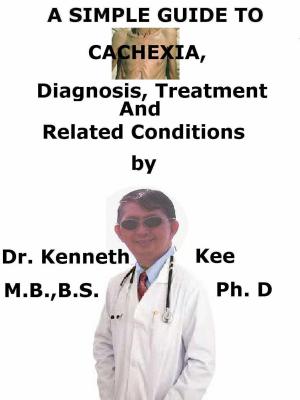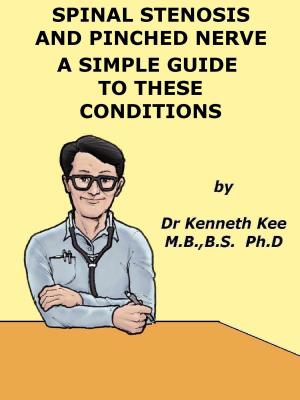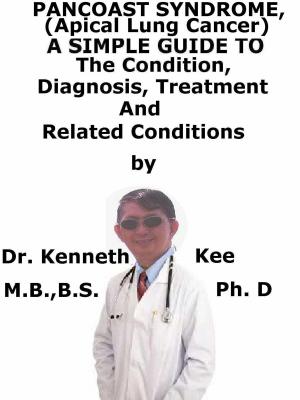Ludwig’s Angina, A Simple Guide To The Condition, Diagnosis, Treatment And Related Conditions
Nonfiction, Health & Well Being, Health, Ailments & Diseases, Oral Health, Medical, Infectious Diseases, General| Author: | Kenneth Kee | ISBN: | 9781370060634 |
| Publisher: | Kenneth Kee | Publication: | May 25, 2017 |
| Imprint: | Smashwords Edition | Language: | English |
| Author: | Kenneth Kee |
| ISBN: | 9781370060634 |
| Publisher: | Kenneth Kee |
| Publication: | May 25, 2017 |
| Imprint: | Smashwords Edition |
| Language: | English |
Ludwig's angina is a rare bacterial infection that infects the floor of the mouth.
It normally happens if a tooth infection is left not treated.
If the disorder is not promptly treated it can result in severe complications and can be fatal.
Ludwig's angina is an acute cellulitis in the area of the sub-mandibular gland.
It is most often because of sepsis in the throat or mouth which spreads to the sub-mandibular space.
Sometimes, it may be the effect of suppuration in the sub-mandibular gland itself.
Ludwig's angina, also called angina ludovici, is a serious, possibly life-threatening cellulitis, or connective tissue infection, of the floor of the mouth, normally happening in adults with concurrent dental infections and if left not treated, may block the airways, requiring tracheostomy
Ludwig's angina indicates the feeling of strangling, not the feeling of chest pain, though there may be chest pain in Ludwig's angina if the infection spreads into the retro-sternal space.
The life-threatening nature of this disorder normally indicates surgical treatment with involvement of critical care doctors such as those found in an intensive care unit
It often forms after an infection of the roots of the teeth (such as tooth abscess) or a mouth injury.
Ludwig's angina is bacterial in origin often caused by Streptococcus, Staphylococcus and Bacteroides species.
It is mainly caused by infection of the second and third molars as the roots of these teeth have direct entrance to the sub-maxillary space.
Other causes of Ludwig's angina are:
1. Dental abscesses
2. Dental injury or trauma can also produce Ludwig's Angina
3. Peritonsillar or parapharyngeal abscesses
4. Mandibular fractures
5. Oral lacerations and piercings
6. Oral cancer
Pre-disposing factors are:
1. Poor oral hygiene
2. Dental caries
3. Recent dental treatment or tooth extraction
4. Underlying systemic disorders such as diabetes, alcoholism, poor immunity, malnutrition etc.
Symptoms are:
1. Breathing difficulty
2. Difficulty swallowing
3. Drooling
4. Unusual speech (sounds like the person has a "hot potato" in the mouth)
5. Tongue swelling or protrusion of the tongue out of the mouth
6. Fever
7. Neck pain
8. Neck swelling
9. Redness of the neck
The doctor will do an examination of the neck and head to look for redness and swelling of the upper neck, under the chin.
The swelling may extend to the floor of the mouth.
The tongue could be swollen or out of place.
The patient may require a CT scan.
MRI with contrast and CT scan of the head and neck region are done for find out the extent of infection.
Fluid cultures are done for detection of the causative organism.
Treatments precedence is:
1. Airway safety,
2. Antibiotic treatment, and
3. Surgical drainage.
A breathing tube may need to be placed through the mouth or nose and into the lungs to restore breathing.
If the swelling blocks the airway, the patient needs to get emergency medical help right away.
This is done through an intervention called tracheotomy, where a small opening is created surgically directly into the windpipe through the neck
The surgery called a tracheostomy creates an opening through the neck into the windpipe.
In some patients, a tube is inserted through the nose into the lungs for maintaining the airway.
Antibiotic medicines are advised for treatment of the underlying bacterial infection.
The selection of antibiotic should be broad spectrum and fight against anaerobic, gram-negative and gram positive organisms.
The combined usage of penicillin, metronidazole and clindamycin is given until an appropriate antibiotic is chosen after culture and sensitivity.
Surgery may be required to drain fluids that are producing the swelling.
TABLE OF CONTENT
Introduction
Chapter 1 Ludwig’s Angina
Chapter 2 Causes
Chapter 3 Symptoms
Chapter 4 Diagnosis
Chapter 5 Treatment
Chapter 6 Prognosis
Chapter 7 Vincent’s Angina
Chapter 8 Sialadenitis
Epilogue
Ludwig's angina is a rare bacterial infection that infects the floor of the mouth.
It normally happens if a tooth infection is left not treated.
If the disorder is not promptly treated it can result in severe complications and can be fatal.
Ludwig's angina is an acute cellulitis in the area of the sub-mandibular gland.
It is most often because of sepsis in the throat or mouth which spreads to the sub-mandibular space.
Sometimes, it may be the effect of suppuration in the sub-mandibular gland itself.
Ludwig's angina, also called angina ludovici, is a serious, possibly life-threatening cellulitis, or connective tissue infection, of the floor of the mouth, normally happening in adults with concurrent dental infections and if left not treated, may block the airways, requiring tracheostomy
Ludwig's angina indicates the feeling of strangling, not the feeling of chest pain, though there may be chest pain in Ludwig's angina if the infection spreads into the retro-sternal space.
The life-threatening nature of this disorder normally indicates surgical treatment with involvement of critical care doctors such as those found in an intensive care unit
It often forms after an infection of the roots of the teeth (such as tooth abscess) or a mouth injury.
Ludwig's angina is bacterial in origin often caused by Streptococcus, Staphylococcus and Bacteroides species.
It is mainly caused by infection of the second and third molars as the roots of these teeth have direct entrance to the sub-maxillary space.
Other causes of Ludwig's angina are:
1. Dental abscesses
2. Dental injury or trauma can also produce Ludwig's Angina
3. Peritonsillar or parapharyngeal abscesses
4. Mandibular fractures
5. Oral lacerations and piercings
6. Oral cancer
Pre-disposing factors are:
1. Poor oral hygiene
2. Dental caries
3. Recent dental treatment or tooth extraction
4. Underlying systemic disorders such as diabetes, alcoholism, poor immunity, malnutrition etc.
Symptoms are:
1. Breathing difficulty
2. Difficulty swallowing
3. Drooling
4. Unusual speech (sounds like the person has a "hot potato" in the mouth)
5. Tongue swelling or protrusion of the tongue out of the mouth
6. Fever
7. Neck pain
8. Neck swelling
9. Redness of the neck
The doctor will do an examination of the neck and head to look for redness and swelling of the upper neck, under the chin.
The swelling may extend to the floor of the mouth.
The tongue could be swollen or out of place.
The patient may require a CT scan.
MRI with contrast and CT scan of the head and neck region are done for find out the extent of infection.
Fluid cultures are done for detection of the causative organism.
Treatments precedence is:
1. Airway safety,
2. Antibiotic treatment, and
3. Surgical drainage.
A breathing tube may need to be placed through the mouth or nose and into the lungs to restore breathing.
If the swelling blocks the airway, the patient needs to get emergency medical help right away.
This is done through an intervention called tracheotomy, where a small opening is created surgically directly into the windpipe through the neck
The surgery called a tracheostomy creates an opening through the neck into the windpipe.
In some patients, a tube is inserted through the nose into the lungs for maintaining the airway.
Antibiotic medicines are advised for treatment of the underlying bacterial infection.
The selection of antibiotic should be broad spectrum and fight against anaerobic, gram-negative and gram positive organisms.
The combined usage of penicillin, metronidazole and clindamycin is given until an appropriate antibiotic is chosen after culture and sensitivity.
Surgery may be required to drain fluids that are producing the swelling.
TABLE OF CONTENT
Introduction
Chapter 1 Ludwig’s Angina
Chapter 2 Causes
Chapter 3 Symptoms
Chapter 4 Diagnosis
Chapter 5 Treatment
Chapter 6 Prognosis
Chapter 7 Vincent’s Angina
Chapter 8 Sialadenitis
Epilogue















